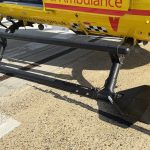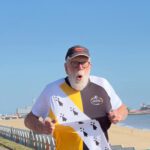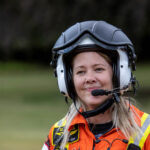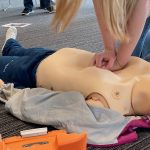6 Aug 2025
The early days of EAAA
Dr Jeremy is one of EAAA’s longest serving doctors, having been with the charity for over 23 years. He completed his first shift as a volunteer doctor in April 2002 so, for this special Clinical Corner, we asked Dr Jeremy to recall his early days with the newly founded East Anglian Air Ambulance.
“I had worked on London HEMS (Helicopter Emergency Medical Service) in 1998, and on BASICS (British Association for Immediate Care), which is a network of volunteer doctors and paramedics, since 1995. I moved to Suffolk in 2001 and, in August of that year while working at the West Suffolk Hospital, I bumped into the then-CEO of the hospital in the corridor. She mentioned that the new East Anglian Air Ambulance was coming in for a cheque presentation and I should come along and say hello…
My first shift with EAAA was in April 2002 when the crew consisted of one pilot, a paramedic and a doctor. While I can’t recall the taskings from that first shift, but I do remember we had a diary to manually record how many jobs we had been to.
In the early days, space on the aircraft was limited so we carried very little equipment. One essential item was an extremely heavy Zoll monitor, basic by today’s standards but vital providing ECG, defibrillation and end tidal CO2 monitoring. Today’s Zoll monitors offer all that and more, including multi-modality monitoring of critically ill or injured patients, providing similar monitoring and care to that of an emergency department.
In the rear of the very small 105 aircraft, I would sit in the back facing sideways, with a paramedic on my left. If we carried a patient, we would load them from the rear of the aircraft, but we would have to turn the paramedic’s seat around to make space.
One of my earliest EAAA memories was being called to Elveden in Suffolk to the fire at the Center Parcs resort. Thankfully, no medical help was needed, but we flew a fire officer over the scene so he could assess how extensive the fire was.
We had the same mixture of jobs in the early days as we do now; cardiac arrests, accidental injuries and road traffic collisions (RTCs). We attended many RTCs because injuries sustained in these would often be serious. While car and road safety has improved significantly since then, RTCs still account for a fifth of the incidents to which EAAA crews are tasked.
Over the last 25 years, kind and very generous donations from people in the communities we serve have enabled every aspect of the organisation to change and develop to meet the need in our region. Thanks to you, we’ve grown into a responsive, innovative service – and it has been truly exciting to see this evolution to deliver the highest quality care for patients across East Anglia. The introduction of aftercare support and community CPR training has been significant, as has the development of governance, record keeping, kit carried, and of course we now have two state-of-the-art H145 helicopters and critical care cars, which enable us to carry the advanced equipment and medication needed to deliver life-saving critical care 24/7.
At the heart of it all – is you. Thank you for keeping us flying and responding for 25 years.




